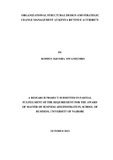| dc.description.abstract | The link between strategy and the structure of the firm is a largely neglected area in strategy implementation. Successful strategy execution depends on doing a good job of working with and through others, building and strengthening competitive capabilities, motivating and rewarding people in a strategy-supportive manner, and instilling the discipline of getting things done. This study sought to ascertain the significance of organization structure in the strategic change management process. Several studies have been done on the different challenges affecting strategy implementation, but not much has been done to explore the possibility that the existing structures could in fact be the greatest impediment to implementation of strategic change in public institutions. That perhaps, there could be structural resistance to change. The objectives of this study were to determine factors that necessitated organizational restructuring at KRA and to determine how such restructuring underpin strategic change at KRA.
This study utilized the case study design on the Kenya Revenue Authority, the principal tax-collecting agent of the government of Kenya. Primary data was collected using an interview guide. The study targeted eight senior managers and two supervisors in various departments. Data was analyzed using content analysis.
The study found that the organizational structural design had a significant impact on the success of the strategic changes that have taken place in KRA over the last ten years. There appears to have been a deliberate attempt to embed structural changes in the overall strategic change management process at the organization.
The factors that necessitated organizational restructuring were found to be; a need to increase efficiency and service delivery, the need to reduce corruption, to increase revenue collection, to get to the world standards of tax administration as well as changing legislation.
Other factors that had a positive impact on change management process at KRA included good and focused leadership, support by government, political will, dedicated staff, investment in technology and a dynamic strategic planning process. Acceptance of changes by key stakeholders was also a critical success factor. Delay of funding from Treasury was cited as a critical impediment to the change process. Other impeding factors include inadequate technical know-how by both KRA staff and taxpayers, incompatibility of IT systems of taxpayers vis-à-vis those of KRA, resistance to change by some employees and taxpayers, corruption, lack of role clarity and an antagonistic relationship between some departments.
Structure is the implementation mechanism of the organization. It serves as the backbone or framework upon which, the organization executes its programs, plans and objectives. The study recommends a proper structural analysis in the strategy process. Structure has to be supportive of the mission and objectives of the organization. Therefore, strategic change management process ought to take cognizance of the structural configuration to facilitate a smoother transformation.
The study further recommends that KRA adopt a flatter and more flexible structure to enhance the organization’s agility in responding to changes in the environment. Furthermore, reduce the span of control of the commissioner general so that he/she has more time to concentrate on strategic issues, which affect the performance and long-term success of KRA. The government should allow more freedom to the board and management of KRA by adopting a broad-based board selection approach and granting the commissioner general security of tenure. Amend the law to allow KRA to withhold its share of revenue collected per the agency agreement to enable it adequately plan its activities. The departments and programs spearheading the change process should be adequately empowered and funded to execute their mandates. The study further recommends proper training of employees and taxpayers on their role and sensitization on expectations of the changes, through an effective communication and feedback mechanism. | en |

